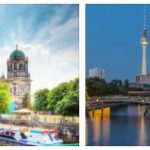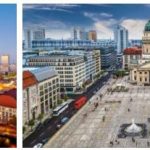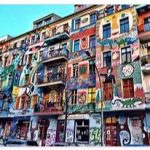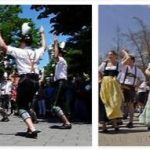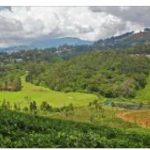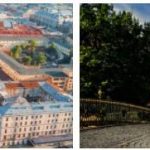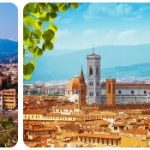The Maria Regina Martyrum memorial church (1963; with mural by G. Meistermann) and the special memorials of July 20 in Plötzensee and in the former Bendlerblock, Stauffenbergstrasse, commemorate those executed during the National Socialist dictatorship. In 1948 the Soviet memorial was erected in Berlin-Tiergarten, and in 1949 in Berlin-Treptow. In the east of the city, new residential and individual buildings have been built since 1951, initially historicizing (Karl-Marx-Allee [former Frankfurter Strasse and Frankfurter Allee, 1949–61 Stalinallee]; gap development »Unter den Linden«; residential areas »Fischerinsel«, Leipziger Street, Rathausstraße).
The old center of the city around Alexanderplatz with the office buildings »Berolina« and »Alexander« (1929 and 1932 von Behrens) received i.a. with the 368 m high television tower (1966–69), the ensemble of the Haus des Lehrers and the congress hall (since 2003 Congress Center) and the Hotel “Stadt Berlin” (1969, today “Park Inn”). 1973–76 the Palace of the Republic (demolished in 2006 ff.), Formerly the seat of the People’s Chamber, was built on the former Marx-Engels-Platz (today Schlossplatz); In 1984 the new Friedrichstadtpalast was built; By 1987 the Nikolaiviertel was rebuilt using modern construction elements. In 1988, the reconstruction of the New Synagogue began in Oranienburger Strasse (1857 ff., Destroyed in 1943), which – restored and partially redesigned – was handed over to its intended purpose in 1995 as the Centrum Judaicum.
With the new function of Berlin as the capital of reunified Germany, rapid urban development began with the participation of leading architects from home and abroad. The city became the largest construction site in Europe, especially with the projects in the government district with the Bundestag, Bundesrat and Chancellery in the Spreebogen as well as the Spreeinsel, Alexanderplatz, Potsdamer, Leipziger and Pariser Platz centers. A. Schultes and Charlotte Frank created the design for the new building of the Federal Chancellery (1997–2001); the Paul-Löbe-Haus and Marie-Elisabeth-Lüders-Haus, which serve the MPs and other parts of the federal administration, were designed by S. Braunfels (1995–2002).
M. Ungers received the contract for the urban quarter at Lehrter Bahnhof in 1994. The contract for the station itself, the new Berlin Central Station (1998–2006), went to the architects Gerkan, Marg & Partner. After the resignation of Konrad R. D. Gutbrod (1984), Christoph Sattler and Heinz Hilmer were responsible for project management and further planning for the buildings of the Kulturforum: After »Piazetta« (1991) and the main entrance hall of the museums and the building for the Kupferstichkabinett with art library (1994) the picture gallery was built (completed in 1998). R. Piano and Christoph Kohlbecker In 1992, as chief architect of Potsdamer Platz, took over one of the city’s largest projects; Participating architects: i.a. A. Isozaki, H. Kollhoff, Ulrike Lauber and Wolfram Wöhr, R. Moneo and Sir R. Rogers; the Sony complex was built by H. Jahn (opened in 2000), the Beisheim Center by the architects Hilmer & Sattler und Albrecht (opened in 2004). The concept for the new building for the Berlin Academy of the Arts (inaugurated in 2005) on Pariser Platz next to the Hotel Adlon was developed by G. Behnisch in collaboration with Manfred Sabatke and Werner Durth. D. Libeskindcreated the design for the Jewish Museum (1992–99, opened as a museum in 2001; extension building opened as an academy in 2012). As the youngest new museum building, the Museum der Moderne will be built next to the Neue Nationalgalerie on the Kulturforum from the mid-2020s (architects Herzog & de Meuron). A Holocaust memorial (»Memorial to the Murdered Jews of Europe«), consisting of a walk-in, approximately 19,000 m 2 large field with 2,711 concrete steles that protrude up to 4.70 m from the ground and an underground »Information Center «, Was built near the Brandenburg Gate according to the design of the American architect P. Eisenman (2000-04, opened 2005).
An underground memorial (1995) by the Israeli artist M. Ullman commemorates the book burning of May 10, 1933 on Bebelplatz. For the international exhibition and documentation center “Topography of Terror”, started in 1995 according to plans by P. Zumthor and abandoned in 2004 (dismantling of the shell in 2004/05), a new competition was announced in April 2005, from Ursula Wilms from the Berlin office Heinle, Wischer und Partner and the landscape architect Heinz W. Hallmann emerged victorious; In autumn 2007, work began on the rebuilding of the site on which the headquarters of the Secret State Police, the SS and the Reich Security Main Office were located at the time of National Socialism. The documentation center was opened in May 2010. On October 24, 2012, south of the In the Reichstag building, the memorial to the European Sinti and Roma who were persecuted and murdered as »Gypsies« under National Socialism was inaugurated (design by D. Karavan).
The following were added to the list of UNESCO World Heritage Sites: 1990 the palaces and parks of Potsdam and Berlin, the Glienicke hunting lodge (1682–86, later changes; severely damaged in a fire in 2003) with the garden designed by P. J. Lenné (1860–62, 1986–88 reconstructed), the Pfaueninsel as well as the Sacrower Schlosspark with the Heilandskirche (1841/42) bordering Berlin and already belonging to Potsdam; 1999 the Museum Island in Berlin-Mitte; In 2008 the Berlin Modernist housing estates built between 1913 and 1934 (which, with their rationally designed and modernly equipped apartments with lots of light, air and sun, provided international architectural models for the entire 20th century): the garden city of Falkenberg (Treptow), the Schillerpark settlement (Wedding), the horseshoe settlement Britz (Neukölln), the residential area Carl Legien (Prenzlauer Berg), the White City (Reinickendorf) and the Siemensstadt housing estate (Charlottenburg and Spandau).

